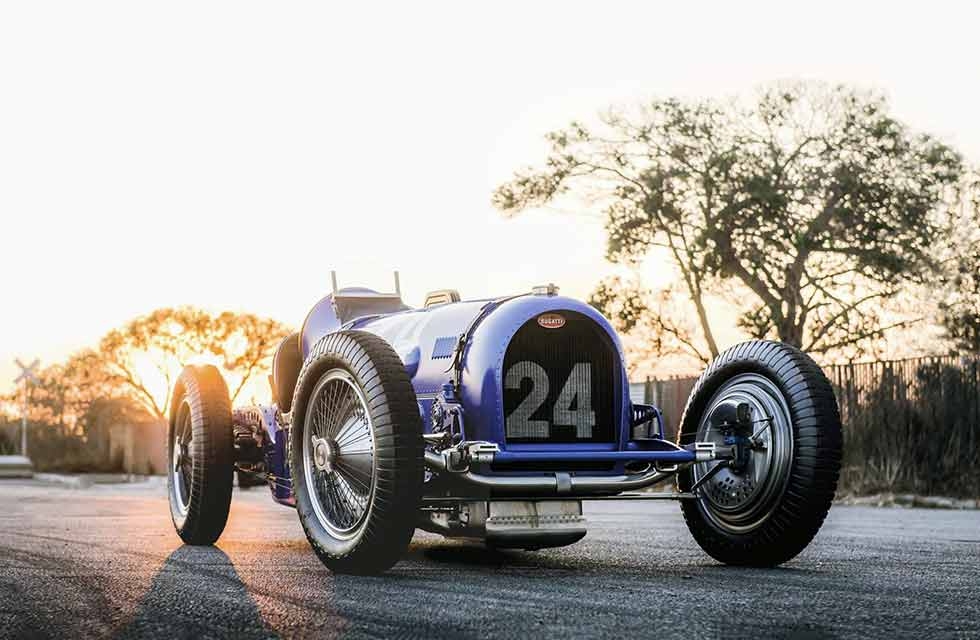
Lifelong Bugatti enthusiast Ray Jones owned a record- breaking Bugatti engine and the frame of a fabled works Type 59. So his son built him the body to go with it… Words Massimo Delbo. Photography Jamie Lipman.
‘I FLOOR THE AGGELERATOR AND, SUDDENLY, I UNDERSTAND THE RAGING ORIGINS OF THE TYPE 59’
MASSIMO DELBO
‘We shot the Bugatti Type 59 in a cul-de-sac where local bad-asses practise doughnuts. They got curious, passing closer each time, smoking their rear tyres. Then the sound of our engine drowned all of theirs. This 85-year-old racing lady was the coolest – and fastest – steed of the day.’
MONSTER 150MPH BUGATTI T59
Re-created racer as great as the sum of its parts
Europe was still relatively peaceful in 1935. Yes, tension between countries was on the rise, with Italy’s Mussolini looking for territory in Africa, England defending the Treaty of Versailles, and Hitler’s power growing in Germany. Yet there was one topic on which the leading nations of Europe could agree – and that was motor racing, which was universally seen as a window in which to promote technical excellence.
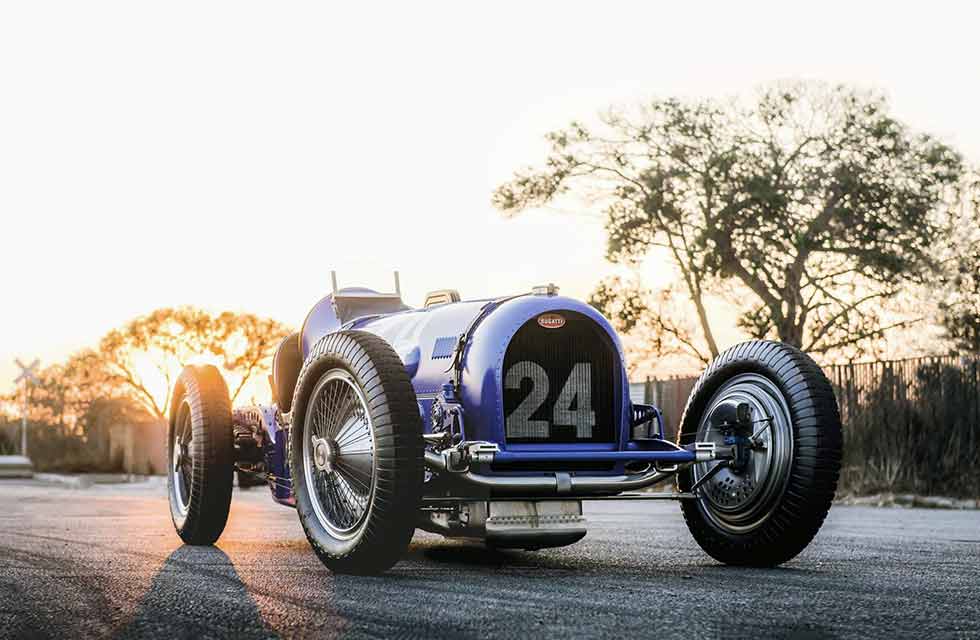
That year, the 29th Grand Prix de l’Automobile Club de France was held at Montlhery on 23 June. It was fully 500km in length and run as part of the European Championship, back then the most prestigious in the racing car world. Rudolf Caracciola won, driving his Mercedes-Benz W25 (chassis no 109975/7), an almost unbeatable car that had been created specially for the 1934 GP formula with its 750kg weight limit. Such was the importance Hitler attached to his country’s dominance in the sport that, in 1935-1939, German cars won every single championship Grand Prix except the 1935 German race, which was won by Alfa Romeo.
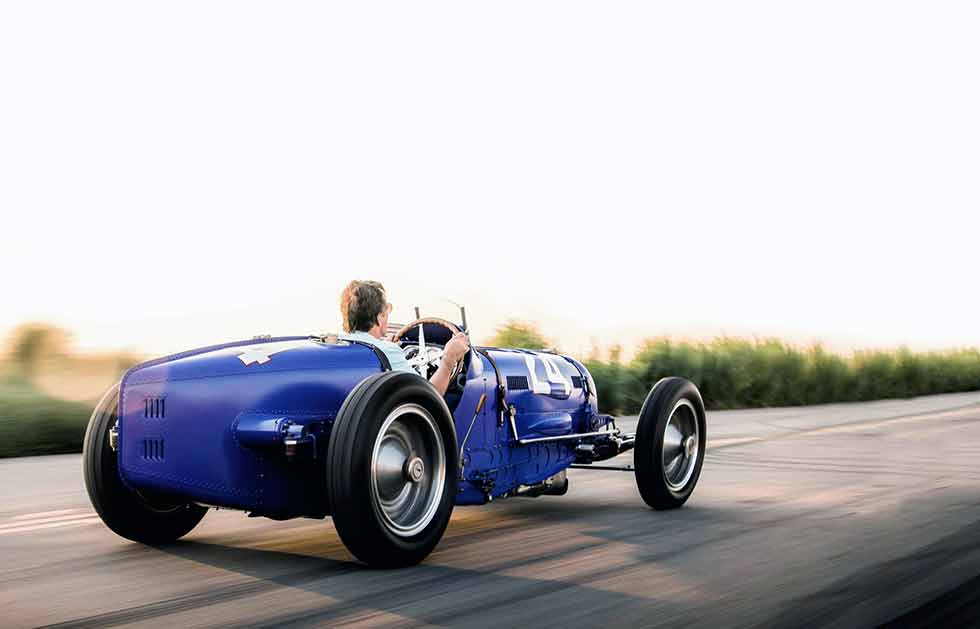
Meanwhile, with almost no government support, French manufacturers were fighting an unequal battle. Ettore Bugatti was in the front line: his company, founded in 1909, was the most successful the racing world had seen, thanks to the legendary success of such models as the Type 35, which accounted for 500 victories in less than two years. And away from the grind of the Grand Prix, Bugatti had been demolishing speed records.
In May 1933 the Polish-born French citizen Count Stanislaw Czaykowski drove a Bugatti Type 54 at Berlin’s Avus track. His car was equipped with a special supercharged 4972cc straight-eight and, after two days of practice and a couple of warming laps, he set average-speed records that included 100km at 131.88mph, 200km at 132.85mph, and the all-important One Hour record at 132.87mph. He died shortly after, during the Monza Grand Prix of September 1933.
When the new 750kg rules were declared for 1934, Bugatti’s answer was the Type 59, with a lower-slung body and chassis to lower its centre of gravity. It looked rather like its Type 51 and 54 predecessors and, equipped with a 2821cc straight-eight with Roots compressor, it made its debut at the Spanish Grand Prix in September 1933. After the following year’s Monaco Grand Prix, the engine was enlarged to 3257cc, its bore increased by 72mm. As usual, after an initial period during which the latest model was used by works drivers, the cars were made accessible to privateers. In total, only eight Type 59s were built, and in 1935 just a couple were retained for the works team of Robert Benoist and Jean-Pierre Wimille.
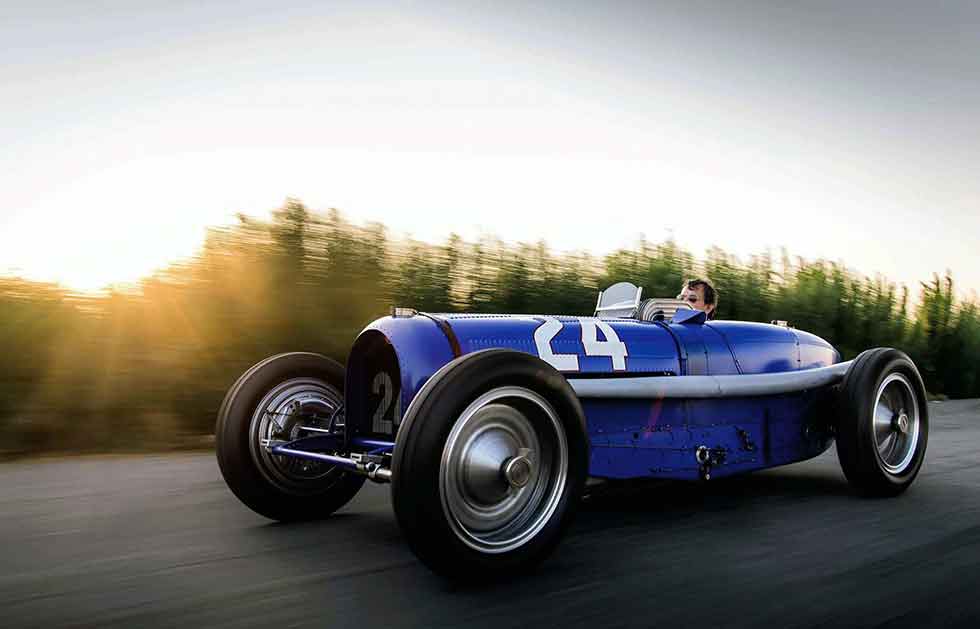
Robert Marcel Charles Benoist was born, the son of Baron Henry de Rothschild’s gamekeeper, in March 1895 in Rambouillet, a small city in the north of France, where the castle remains the official country residence of the French President. Raised in a humble country family, he became an apprentice mechanic in a Versailles garage before being conscripted into the French Infantry during World War One. He volunteered to become a fighter pilot for the just-founded Armee de l’Air and then a flying instructor.
At the end of the war, he become a test driver for the French manufacturing firm De Marcay, before moving to Salmson (famous for its aviation engines), there he started racing before joining Delage in 1924. With Delage he achieved fame and success, winning four Grands Prix in 1927 and dominating the manufacturers’ championship in the days before there was one for drivers.
But as Louis Delage ran out of money, he was forced to close the racing department and make Benoist redundant. So Benoist became sales manager at the Banville Garage of Paris, the world’s first multi-storey car park, with two floors underground and five above, the last dedicated to indoor tennis courts, a gymnasium and a restaurant, linked by a curling ramp. To promote the garage – and the Bugatti dealership within it! – Benoist came up with the idea of a hillclimb race on the 600m-long ramp linking its floors.
In 1928 he started racing for Bugatti, though in 1929 he won the 24 Hours of Spa with an Alfa Romeo 6C-1750 Zagato when Bugatti pulled out of racing. When Bugatti returned in 1934, Benoist was enlisted in the works team that he went on to manage. A year later he was behind the wheel of a very special Bugatti Type 59/50S for the French Grand Prix.
the car, frame number 6, was equipped with the one-off 4972cc engine (number 8) used in 1933 by Count Czaykowski to break the speed records. During the race, the only one the car ever took part in, it proved fast yet suffered a series of problems, including the loss of its bonnet, which forced Benoist to drive back to the pitlane while holding on to what was left of it. He rejoined the competition, but after 16 laps was forced to retire – and little was known about the fate of the car since that race.
What is certain is that the Second World War had a deep impact on both Benoist and Bugatti. Benoist entered the French Resistance – today he’s remembered as a hero within it – but he was executed on 12 September 1944 at the Buchenwald concentration camp. Meanwhile, Bugatti was forced to sell his company during the War and to close it soon after.
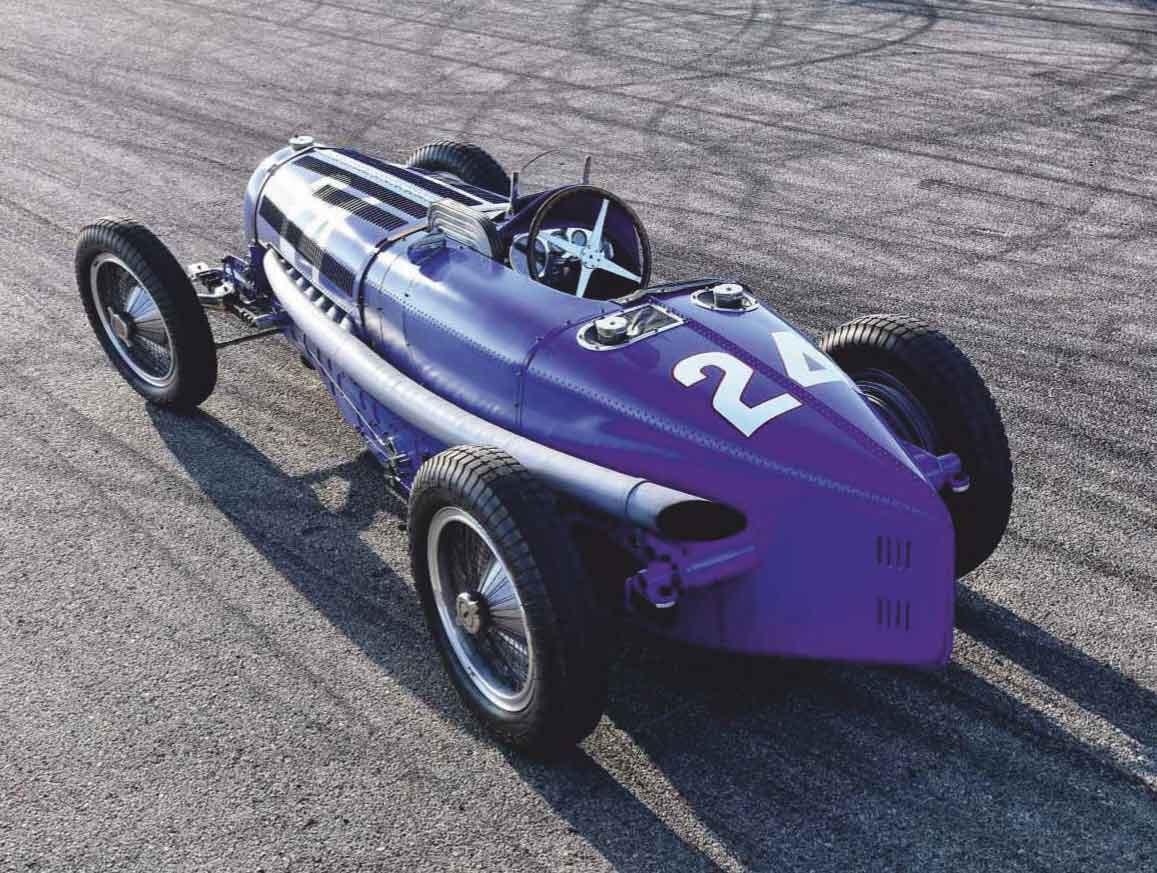
Fast-forward to 1968, when the American Bugatti arch-enthusiast Ray Jones, during one of his frequent journeys to the closed factory at Molsheim, was made aware that the French Government had decreed that all the material left there should be sent to the foundry, the unhappy workers loaded wagon after wagon with chassis, engine blocks, cylinder heads, bodies, mechanical components and so on. But Jones had the money to buy some of them, and took 40 tonnes of parts to go with the Type 59 frame he’d already acquired.
‘Almost all later Bugatti chassis frames are number-stamped,’ says Ray Jones’ son, Greg, a restorer and Bugatti specialist himself. ‘On Type 59s, the number is located centrally, on the back of the tubular rear crossmembers.’ these frame numbers are distinct from chassis numbers, which were never stamped on the frame but only on the chassis plate, and there is not a direct correlation between the two.
‘My father had found frame number 2, and this was the one we used to form the basis of the recreation of the Benoist 1935 Type 59/50 Bugatti. the engine, the correct “number 8”, came from Type 53 chassis no 53002 in the De Dobbeleer dealership, which had been sold to American collector Carlton Coolidge of Ohio in 1970 and subsequently sold to dad.’
Engine number 8 is a prototype design for the Type 59/50 B cars that came later, and is easy to spot because it has many different parts. It is an iron-block unit, with a unique, larger sump and a larger blower and is not stamped on the sump, but on various internal parts, there are three Zenith 48K carburettors, angled at 45° to fit under the supercharger, that feed into the full-length inlet port, and it has twin parallel outlet ports, which feed into a pair of matching ports in the large cast alloy inlet manifold, one supplying the inner four-cylinder block ports and the other the outer four, via two smaller manifolds.
‘Many other components, bought as parts, are Type 59 too,’ adds Greg, referring to the original Type 59 split front axle and four-speed gearbox – number 4, which is stamped on the double-reduction rear axle, complete with the heavier ZF limited-slip differential, the gearlever is outside the cockpit, the handbrake lever inside, and there are De Ram dampers (newly developed for the 750kg formula), a bigger exhaust and wider rear wheels.
‘the rest of the car is made with almost all original, refurbished parts from different models and very little had to be remanufactured by us,’ says Greg. ‘In the process we discovered that some of the parts, such as for the tank, were actually from the Benoist car. We followed the
Bugattis spirit, with the concept of recreating the 59 as it had originally been built in Molsheim, and very little of it is not original Bugatti, as reported by British Bugatti historian David Sewell after his inspection.’
the body is a different story, however, being a completely new recreation, following the original drawings and pictures from the period. ‘We were left without any other option,’ says Greg. ‘It is strongly believed that the original body was lost forever. It has never been seen since the 1935 French GP, and we all know how valuable alloy was during and after the War. We did our best to match the original.’
The reason behind this recreation is one of family love. ‘My father spent years collecting, trading and loving these cars and many other classics. We knew he had this dream of being able to drive the record-breaking engine, and spent a lot of time putting together the necessary components. When we were looking for an idea for his 90th birthday, my brother and I decided to move forward with this recreation. We had 18 months, which wasn’t long, the engine, amazingly the most complete part we had, was the most difficult to restore. We had to check tolerances, fix cracks and try to understand the many unique solutions it featured.
‘On the other hand, the gearbox was very easy, because it was originally built to handle more power. I will never forget when we started the engine for the first time and, after a lot of tuning, then drove the car the first time. Unfortunately dad is not able any more to get in and drive it, but most of the time we were driving, he was close by and enjoyed the sound of the car starting and passing by.’
These words are the ones I vividly remember while stepping into the cockpit; I’m 40 years younger than Ray Jones, but I wonder if I will ever be able to get back out of the Type 59. As always when driving a pre-war racing Bugatti, in order to operate the accelerator pedal I have to remove my right shoe – the resulting hole in my sock is a price I’m happy to pay. The estarting procedure is straightforward: external battery, side cranks, and soon a loud, deep, roar engulfs me. It is amazing how, even at idle speed, the eight-cylinder voice is so deep that you feel it as much as hear it, through your whole body but mostly as it reverberates in your chest.
Steering is direct but not difficult, the clutch is heavy, the gearbox feels strong. Select first, just a few revs and I’m off. It’s like riding a racing thoroughbred out of the paddock: you set off slowly yet immediately you can tell that you are in charge of something special. Second gear, and the thunder revolving around me starts to fade in the wind. Third gear, a little more gas, and I acclimatise further as we build up speed.
The ride quality is impressive, so much better than you’d expect of a racing car of the period. And while the Type 59 is physically big, it doesn’t seem so. Only under braking does it feel its age and only then does its weight become apparent, more than is usual in racing Bugattis. And I don’t know if the gearbox oil is warming up or whether I’m simply becoming accustomed to it, but double-declutching into second gear is not so hard as I’d first thought.
Back on the straight, I floor the accelerator through a couple of gears and, suddenly, I understand the real racing origins of the 59. I’m rocketed forward, with a constant push that seems endless, while the reaction of the rear suspension and tyres indicates the extra work they are doing in transmitting all the power to the tarmac. As my drive comes to an end, I realise that I’m smiling. Broadly. And when I switch off the engine, I’m almost deaf, and covered in dust. What an intense experience.
While I’m describing this emotion to Greg, he is gentleman enough not to show his relief at me returning his father car in one piece, and confirms that the 59 has the same effect on him.
At sunset, one of those magical, orange-hued wonders that southern California does best, my thoughts turn to Robert Benoist, the spiritual father of this car, and his final days, so far removed from this beauty. I wonder if, in his darkest hour, he ever reminded himself of what it felt like to drive this fantastic car.
THANKS TO Greg Jones, Peter Mullin and David Sewell.
TECHNICAL DATA FILE SPECIFICATIONS 1935 Bugatti Type 59/50S
Engine 4972cc DOHC straight- eight, iron block, alloy head, dry sump, three Zenith 48K carburettors, Roots supercharger
Max Power 230bhp @ 5500rpm
Max Torque 289lb ft @ 3500rpm
Transmission Four-speed manual, rear-wheel drive, ZF limited-slip diff
Steering Worm and roller
Suspension Front and rear: beam axles (live rear), leaf springs (semi- elliptic front, quarter-elliptic rear),
De Ram adjustable friction dampers
Brakes Drums, cable-operated
Weight 750kg
Top speed 150mph
Below and right: The Type 59 was designed around new regulations for the 750kg formula, which arrived in 1934, and was lower-slung than its predecessors; the bonnet flew off when Benoist drove his in the 1935 French Grand Prix. Below: A genuine Type 59 frame, the original Czaykowski/Benoist straight-eight, hundreds of original Bugatti parts (including some from the Benoist car) and a body as close to correct as possible.
Above and left: Stripped down to its elements, the artistry of Bugatti’s handiwork is evident. The Jones family prepared many original parts to go with the Type 59 frame and the original record-breaking engine before building a perfect replica body. The engine was the most difficult part of the restoration process. Above and right: That is an extremely special 4972cc straight-eight, one that powered Count Stanislaw Czaykowski to speed records before being installed in Robert Benoist’s Type 59 racer – the car that has been replicated here.






